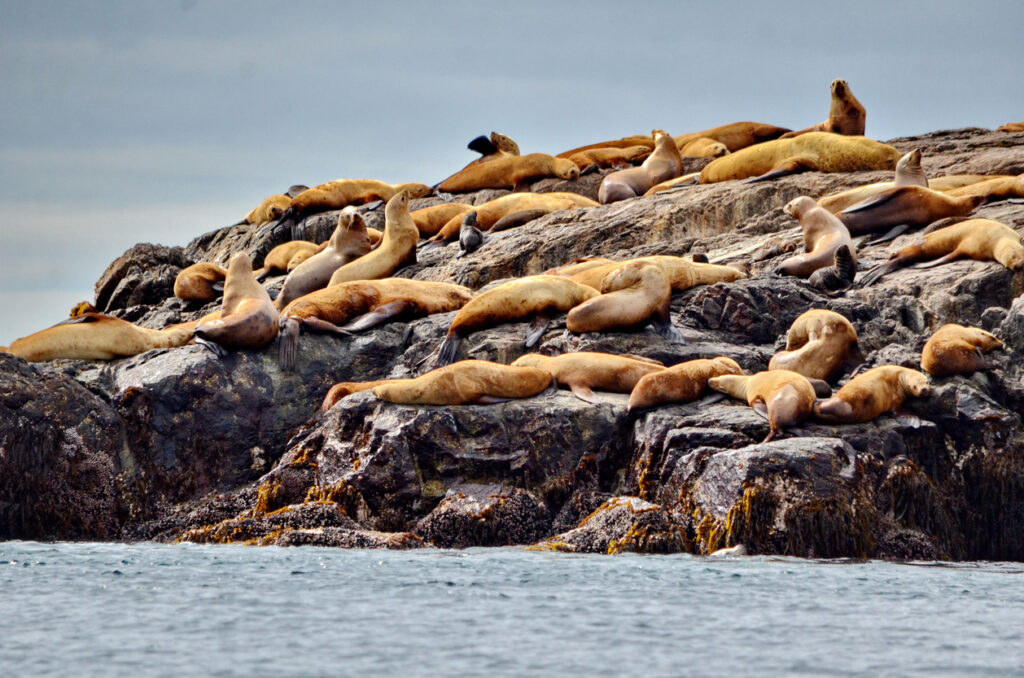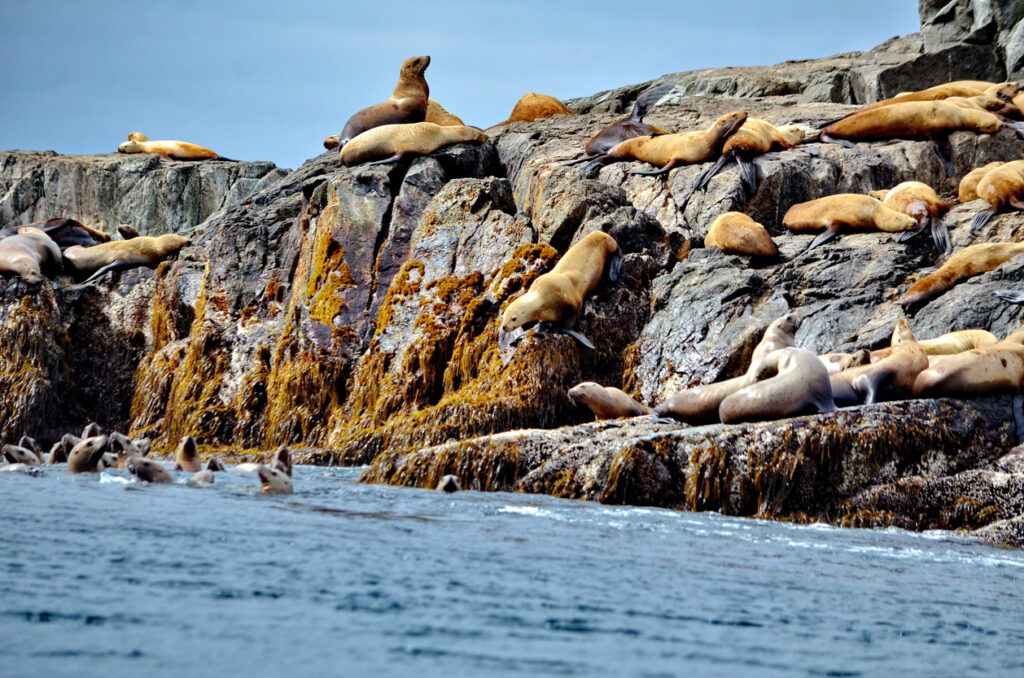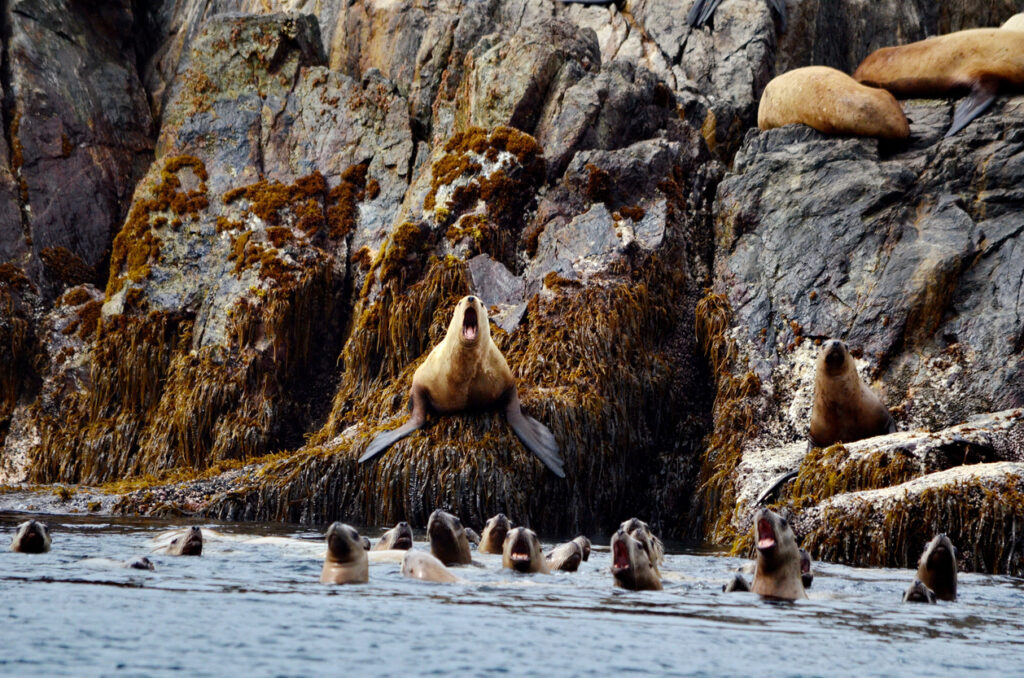Where Haida Gwaii tapers to a storm-scoured point, a scatter of low, wave-washed rocks called the Kerouard Islands cradles one of British Columbia’s most important wildlife sites: the Cape St. James rookery. This is the only Steller sea lion breeding rookery in Gwaii Haanas and one of only a handful along the entire BC coast – an engine for the species’ recovery and a living barometer of ocean health.

Photo by iStock
Where & What It Is
Cape St. James forms the southern tip of Haida Gwaii, just off Kunghit Island, inside Gwaii Haanas National Park Reserve, National Marine Conservation Area Reserve and Haida Heritage Site. The rookery itself sits on the Kerouard Islands – bare, sloping ledges ideal for pupping and hauling out. In a typical summer, more than 600 breeding Steller sea lions crowd these rocks, with males establishing territories and females giving birth and nursing pups from late spring into July.
How & Why It Was Protected
The site’s conservation story mirrors the birth of Gwaii Haanas. Long recognized by biologists – it was noted during BC’s first Steller sea lion census in 1913 – the Kerouard–St. James area gained provincial protection as a British Columbia Ecological Reserve in 1973. When the South Moresby (Gwaii Haanas) protection movement culminated in federal-provincial agreements in 1987–1988, the rookery was folded into Gwaii Haanas National Park Reserve and is now protected under the federal National Parks Act. Today, it is co-managed through a unique partnership among the Council of the Haida Nation, Parks Canada and federal fisheries authorities.
Why protect it so strongly? Because rookeries are the reproductive core of Steller sea lion populations. Disturbance or habitat loss in just a few places can depress pup production across a vast region. Cape St. James is one of BC’s five primary breeding areas and, by some accounts, the province’s second-largest rookery – so safeguarding it yields outsized benefits.

Photo by iStock
Why The Rookery Is Here
Oceanography helps explain the site’s draw. Powerful “Haida eddies” spin off the tip of Cape St. James, concentrating plankton and the forage fish that follow. That productivity cascades upward to seabirds, whales and, crucially, to Steller sea lions that need reliable prey within commuting distance of their pups. The Kerouard ledges add the right real estate: sloped, wave-splashed rock with quick access to deep water and few terrestrial predators.
A Wider Web Of Protection
The rookery doesn’t stand alone. It sits inside a larger ecological mosaic: Gwaii Haanas’ land-sea protected area and an “Ecologically and Biologically Significant Area” (EBSA) at Cape St. James recognized for sea lions, halibut spawning grounds and sensitive deep-sea corals. Nearby islands hold globally significant seabird colonies; St. James Island itself underwent rat eradication in 1998 to boost burrow-nesting seabirds – an example of the intensive restoration that complements rookery protection.
Why It Matters
Species recovery. After Canada prohibited culls and extended protections in 1970, BC’s Steller sea lion numbers rebounded several-fold. Stable, disturbance-free rookeries like Cape St. James were essential to that recovery and remain critical to long-term monitoring. Females show fidelity to their birth sites, so safeguarding one rookery safeguards future generations tied to that place.
Ecosystem health. As top predators, Steller sea lions integrate signals from lower in the food web. Trends in pupping and attendance at Cape St. James help scientists read shifts in forage fish, ocean temperature and currents – insight that can flag broader changes affecting seabirds and whales across Haida Gwaii.
Cultural and collaborative stewardship. The rookery sits within Gwaii Haanas, protected through a landmark Haida–Canada partnership born from the Lyell Island blockades and the South Moresby Agreement. The governance model – Haida stewardship with federal protection – has become a touchstone for conservation done with, not merely on, Indigenous homelands.

Photo by iStock
Visiting Responsibly
Cape St. James is remote, weather-wary and best viewed from the water on guided trips that respect seasonal sensitivities. Gwaii Haanas limits daily entries and requires permits for independent travellers. Marine-life approach distances apply: federal guidelines require boaters to keep well back from marine mammals; in practice, operators give sea lion rookeries a wide berth to avoid disturbance during pupping. Always consult the current Gwaii Haanas visitor guide before planning and follow on-water rules to minimize stress on animals.
Bottom Line
Tucked at the “end of the world,” the Cape St. James rookery is small on a map but huge in consequence. It anchors Steller sea lion reproduction on the North Pacific’s edge, reflects the richness spun up by Haida eddies, and showcases a made-in-Haida-Gwaii model of conservation. Protecting this rookery – by law, by science and by respectful visiting – helps ensure that the Cape’s rocks keep roaring each summer with new life.

